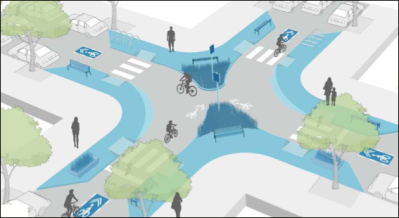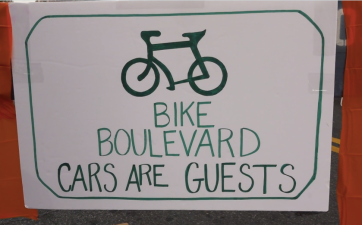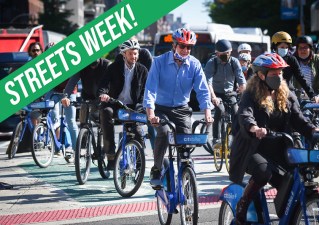‘Bike Boulevards’ Will Be Key to an Equitable COVID Recovery, Mayor Says in ‘State of the City’

You’re getting a bike boulevard, and you’re getting a bike boulevard, and …
In Thursday night’s “State of the City” address, Mayor de Blasio said he would build a “bike boulevard” in every borough by the end of the year, plus create more open streets this year than last, in addition to his already announced plan to add more space for cyclists and pedestrians on the Brooklyn and Queensboro bridges.
It’s all part of a broad post-COVID plan, dubbed, “A Recovery for All of Us,” albeit a little prematurely, given the continued impact of the coronavirus pandemic on normal life in Gotham.
And despite its mandate to document the current “state” of the city, the mayor’s speech was clearly a look to the future, not the present, rolling out a few initiatives to create a stronger city after the virus has receded. Many other long-sought improvements, especially for transit users, were unmentioned.
On the livable streets front, however:
- A “bike boulevard” in every borough, with the rollout beginning this year: Hizzoner described the “boulevards” as “streets that are designed to give bicycles travel priority and put cyclist safety first. These boulevards will have unique design elements to slow vehicle speeds and reduce volume with traffic diverters, signal timing changes, shared streets, open streets and gateway treatments.” Further details were not immediately provided.
- Open streets will be permanent: The mayor had already announced that his COVID-era car-free streets program would be permanent, but on Thursday, he said the city would seek out additional streets with a focus on finding a “local partner” in “underserved neighborhoods.” The open streets plan was criticized for a lack of geographic, racial and social equity.
- The “Bridges for the People” initiative: A few details of the mayor’s plan for the most-cramped East River bridges leaked out before the speech, and little else was revealed. The mayor said all the efforts to increase cycling was part of his larger ambitions on climate change. “The bridges,” he said, “were part of the problem” of auto use.
“These are the kind of changes that allow us to move out of the era of fossil fuels and the era of the automobile, and into a green future as part of our commitment to the New York City Green New Deal,” he said.
More broadly, the mayor offered other open space initiatives for a New York still on its knees from the pandemic:
- A “City Cleanup Corps”: de Blasio said he would create 10,000 part-time positions — which he somewhat inaccurately linked to President Roosevelt’s Depression-era Works Progress Administration and the Civilian Conservation Corps — “for beautification across our city” in the form of removing graffiti, washing sidewalks, tending to community gardens and cleaning neighborhoods. “While the jobs will be temporary for 2021,” he added, “the work done will help drive tourism and confidence, and the wages earned will help drive a recovery for all of us.” The NYC CCC, however, came with a huge “if”: “If the government provides ample direct stimulus support, New York City will be able to create … the City Cleanup Corps.”
- New public spaces for neighborhoods hard hit by COVID: He promised “new spaces” in more than 30 neighborhoods to “help support local small businesses, foster community ties and provide space for arts and culture as we all come back together” — all tailored, he said, to local needs. “Some neighborhoods will have a new pedestrian plaza or new amenities like Greenmarkets and Night Markets,” he added. “Other neighborhoods will have open streets, street seats or completely newly designed open space.” Further details were not initially provided.
And no less important, the mayor made two huge promises regarding the city and the NYPD’s history and ongoing struggle with racist government and law enforcement:
- A Charter commission: de Blasio promised to, this year, create a commission to “identify areas of structural racism in New York City and recommend changes that will root out this systemic rot.” He said such a commission would allow New York to “lead the way in America by speaking openly of the wrongs of the past, creating new approaches to right those wrongs, and enshrining this progress into law.” Which led to his next major announcement…
- A stronger Civilian Complaint Review Board: Naming his plan after late Mayor David Dinkins, de Blasio said the CCRB would get new powers to initiate its own investigations, even without an individual complainant. The CCRB would also be granted “full access to officers’ disciplinary and employment” records. And with a new partnership with the NYPD’s inspector general, the CCRB will:
- Investigate complaints from the public and recommend discipline of officers.
- Conduct regular audits of policing, internal discipline and anti-corruption practices.
- Conduct systemic reviews of NYPD policy and practices, including racially biased policing, and make recommendations for reform, including publishing regular public reports about complaint statistics and public tracking of progress on recommendations.
- NYPD self-policing: The mayor announced the creation of a new committee within the NYPD to review the police Patrol Guide itself. Many instances of questionable police behavior have been dismissed over the years because the actions “were within policy — but the policy itself was problematic,” the mayor said.
Comptroller Scott Stringer praised one of the reforms — giving the CCRB access to police body cam footage — but pointed out that any talk of better police accountability is hamstrung by rules that give the police commissioner the final say over discipline.
“This is a half-measure,” Stringer said in a statement. “As long as the Police Commissioner maintains final say on discipline, so-called civilian oversight will remain toothless. The Police Commissioner has overturned CCRB disciplinary recommendations in more than 70% of serious infractions in the last two decades, and only one CCRB investigation has resulted in the termination of an officer between January 2014 and May 2020.”
And the speech also left out numerous parts of the livable streets movement’s wish list, such as specific promises of key additions to the growing bike lane network, creation of secure and ample bike parking, and anything at all for bus riders. In fact, the words “bus,” “subway,” and “transit” were not used at all in the 3,721-word speech.
Also unmentioned was the unfinished protected bike lane on Queens Boulevard, a glaring oversight, given that the first phases of the project were a much-hyped mayoral success and completion has long been promised.



